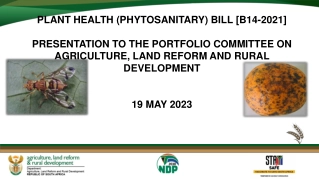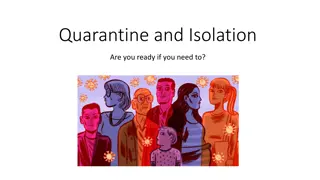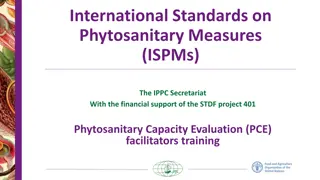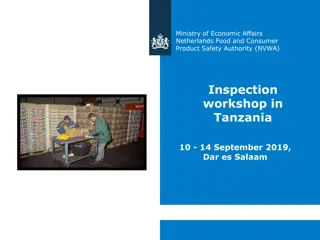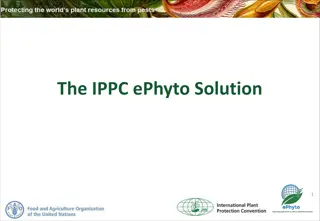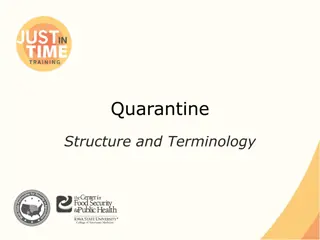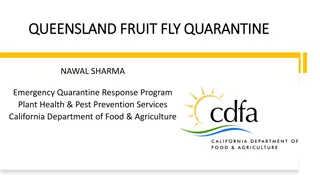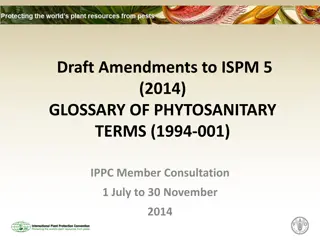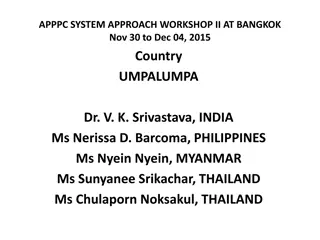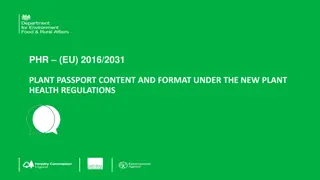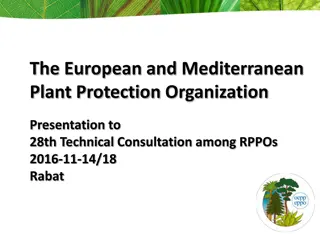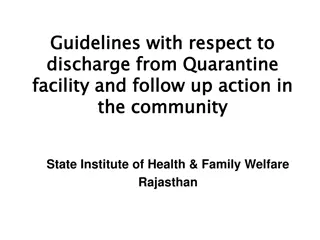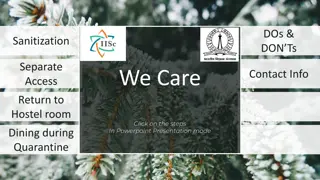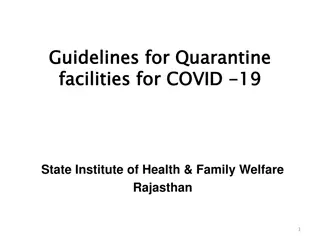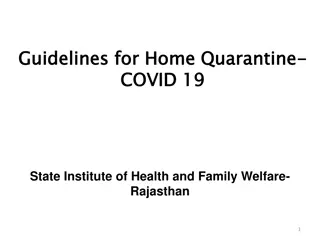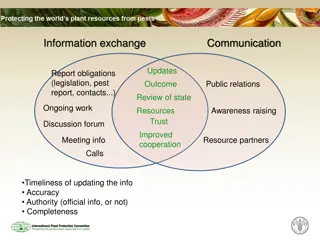Understanding Plant Quarantine and Phytosanitary Measures
Plant quarantine involves efforts to prevent the entry, establishment, or spread of foreign pests through legal restrictions on plant and plant product movement. It is crucial for safeguarding plant health, food production, and ecosystems. Phytosanitary measures aim to ensure the health of plants by addressing pests that require quarantine. This includes inspections, tests, surveillance, and treatments to control regulated pests. The history and significance of plant quarantine services and the role of phytosanitary procedures in issuing certificates are highlighted.
Uploaded on Sep 15, 2024 | 0 Views
Download Presentation

Please find below an Image/Link to download the presentation.
The content on the website is provided AS IS for your information and personal use only. It may not be sold, licensed, or shared on other websites without obtaining consent from the author. Download presentation by click this link. If you encounter any issues during the download, it is possible that the publisher has removed the file from their server.
E N D
Presentation Transcript
Phytosanitary Phytosanitary Status of Bangladesh Bangladesh Status of Md. Ayub Hossain Consultant, SPCB Project, DAE
What is Plant Quarantine ? Plant Quarantine" means the effort to prevent entry, establishment or spread of a foreign pest in the country through legal restriction on the movement of plant and plant products,"
Why is Plant Quarantine ? - Our lives & well-being are based on plant growth and cultivation - Invasive alien species greatly endanger our food production, medication etc. - Expanding global trade, tourism & climate change also increase the dangers - The impact of invasive alien species has serious implications for the economy and ecology.
Plant Quarantine Service Quarantine Service Started from 14thcentury In 1799 USA introduced Quarantine Act. In 1825 UK promulgated Quarantine Act. In 1914 British Indian Governor Promulgated the Destructive Insects and Pest Act General In Protection Convention (IPPC) 1951 FAO started International Plant
Plant Quarantine Service In 1966 Pakistan endorsed Destructive Insects and Pests Rules In 1974 Bangladesh became the member of IPPC In 1989 Bangladesh Destructive Insects and Pests Rules 1966 and the rules is still on Plant Quarantine passed in 2011 New Rules yet to be formulated. amended the Act-2011 has been
What is Phytosanitary ? Phyto means Plant and Sanitary means health so, Phytosanitary indicates concerning the health of plants; especially the freedom from pest which require quarantine. -Phytosanitary Measures means any legislation, regulation or official procedure having the purpose to prevent the introduction and/or spread of quarantine pests.
Phytosanitary contd Phytosanitary method measures inspections, tests, surveillance or treatments in connection with regulated pests. procedure: implementing including official Any phytosanitary performance for the of Phytosanitary phytosanitary procedures leading to the issue of a phytosanitary certificate. certification: Use of
IPPC IPPC (International Plant Protection Convention (International Plant Protection Convention) The IPPC (1952) was first adopted by the FAO Conference at its sixth session in December 1951 by Resolution 85, and came into force inApril 1952. -With the purpose of securing common and effective action to prevent the spread and introduction of pests of plants and plant products, and to promote appropriate measures for their control, the contracting parties undertake to adopt the legislative, technical and administrative measures specified in this Convention (IPPC) and in supplementary agreements
NPPO (National Plant Protection Organization) Each contracting party shall make provision, to the best of its ability, for an official national plant protection organization with the main responsibilities set out in thisArticle. The issuance of certificates relating to the phytosanitary regulations of the importing contracting party for consignments of plants, plant products and other regulated articles;
NPPO of Bangladesh NPPO of Bangladesh The Plant Quarantine activities of the country at national level are under the Director of Plant Quarantine Wing of the Department of Agricultural under the Ministry of Agriculture. He is serving as NPPO of Bangladesh Extension
Organizational Strength Organizational Strength Recently Plant Quarantine Wing of DAE has been formed with headed by Director with 314 personnel. We have 30 plant quarantine stations. Among these stations:-Land 23,International air port-3,Sea port-2,River port-1,Inland container depot (Railway)-1 border check post- Besides these PQ centers, the head quarter at Dhaka carry out the regulatory functions and it also serves as a PQ station.
Function Of Plant Quarantine Wing Function Of Plant Quarantine Wing Enforcement of Destructive Insects and Pests Rules, 1966 (Plant Quarantine) amended up to July, 1989 . Incorporate new Rules Plant Quarantine. and Policies on Promote Plant Quarantine Activities at the Check Posts of the Entry Points.
Issuanceof Phytosanitary Certificate forexportof agricultural products. Issuance of Import Permit for importing Agricultural Products. Issuance of Release Order of Plant Commodities. Recording & Interception of Pests and Diseases.
Main Import Main Import (Plant & Plant Products) (Plant & Plant Products) Rice, Wheat, Maize Raw cotton Fresh fruits Pulses Oil seeds Spices Timbers Vegetables
Main Export Main Export (Plant & Plant Products) (Plant & Plant Products) Jute and Jute products Tea Tobacco Vegetables , Fruits and Potato Frozen vegetables, fruits Food stuffs and Food items Handicrafts, bamboo basket Aromatic and fine rice and spices
Challenges Challenges Lack of awareness about plant quarantine system among different stakeholders ( at policy level, high officials, businessman and mass people level) There responsibilities within the plant health service but the NPPO is an independent body to carry out its tasks effectively in line with the international standard. is a clear structure and division of The financial resources for the NPPO are provided from the state budget. The NPPO is under the Director General of the Department of Agricultural Extension under the Ministry ofAgriculture.
Export Supply Chain Management Export Supply Chain Management Absence of direct linkage Procure through middlemen / farmers Transportation in bus top or loaded truck Lack of supervised production, poor PHH & almost absence of cool chain management Graded & packed in the sheds of exporter Traditional exporters packed in bamboo baskets & 2nd hand paper cartons. No traceability system in place. Acute shortage of air cargo space
Constraints of exportation to EU Constraints of exportation to EU Exporters may be limited by various ways - Potato is ban item to EU Markets -Threats of additional restriction Example: Citrus for canker Vegetable for Thrips Ground nut, chick pea for Khapra beetle. Mustard oil/Pickle for Urecic Acid Chanatur for Aflatoxin.
Constraints) ) Citrus Citrus Export ( Export (Constraints Additional declarations wanted by defra - The fruits shall be free from peduncle and leaves and the packaging shall bear an origin mark -The fruits shall be free from Cercopora angolensis and Guignardia citricarpa -Official control of Xanthomonas campestris (Bacterial canker) - official monthly inspection during 3 months prior to harvesting - Fruits should be treated with sodium orthophenyl- phenate (Article- 15 of EU directives)
Requirements in the EU markets Requirements in the EU markets Produce may be subject to random testing at point of entry, MRLs or other chemical contaminants; Detailed information and records on primary production and post-harvest handling to satisfy the requirements specified under EC/2073/2005 for ensuring food safety of products of non-animal origin EC/852/2004 and
Measures taken for Measures taken for Vegetable & Citrus Exportation Citrus Exportation Vegetable & National & District committee formed for acceleration of citrus & vegetable exportation comprises by DAE, BARI, BADC, Hortex Exporters representatives Foundation and District committee has started their work after receiving producers from Exporters the list of
Farm visit Assessing garden/farm Giving Directives advice according to EU Will production certify the disease free National committee is monitoring the overall activities.
Action Plan Taken to Reduce Interception Action Plan Taken to Reduce Interception Production through Contract Farming Reduction of Fraudulentcertificate Enhancementof inspection facilities Procurementof Laboratory Equipment Pest Listing and PRA Construction of Central packaging house
Background of SPCB Project Background of SPCB Project Bangladesh highly market. amount through exporting 12-14 lakhs metric tons of agricultural products. successfully competitive We are of valuable entered in export significant currency the international earning foreign a To expedite safe and successful trade in developed and developing world we must meet the requirements of the importing country.
As a signatory to the IPPC we have to follow the ISPMs adopted international trade. In order to comply with the WTO-SPS agreement we must update our phytosanitary capacity on a regular basis. by the IPPC for To ascertain the phytosanitary task we need high degree equipment's, trained necessary laboratory facilities in the field of quality control (Plant Quarantine). of quality manpower control and .
Many problems we are facing for exporting citrus and some vegetables to EU that we can not comply with the regulations. EU phytosanitary If we can comply with the International phytosanitary regulations, our agro-products export will be more than doubled. Therefore, our farmers will be benefitted to get fair price and total production will be increased. .
Main Objective of SPCB Project Main Objective of SPCB Project Strengthening phytosanitary capacity in Bangladesh project of DAE going on with following objectives Upgrading 16 Quarantine laboratory Capacity development personnel for relevant Established central packing house at Dhaka.
Conducting PRA & Listing of Pests for 8 crops Establishment of 7 Post entry quarantine centers Construction building and repair maintenance of 7 existing office-laboratory of 6 office-laboratory Introduce system. e-phytosanitary certification
Activities done by Project Activities done by Project Trained 1200 quarantine related personnel Organize 8 awareness building workshop on Phytosanitary measures 1(one) PRA(Pest Risk Analysis) already done & 3(Three) PRA of Wheat, Potato & Mango is in progress Repair maintenance & extension of 7 Office cum laboratory building going on Construction of 4 New office cum laboratory building is in progress
Central packaging house construction process is going on Procurement of Laboratory existing laboratory is going on Quick testing kits of Potato Brown rot already been collected and kits of Bacterial canker of citrus and salmonella of Betel leaf is coming soon for quick testing atAirport. equipment of Handy microscope, Scanner, GCMS, Soft X-ray machine procuring process is under way for safe exportation & importation of Plant & Plant Products.
Conclusion Conclusion To increase successful export capacity building in addressed areas is of prime interest. To be practical, it is, therefore necessary to try to comply with international SPS rules and regulations, both mandatory and improving Citrus , fresh Vegetables & other Plant and plant products export and import. EU Directives, voluntary for
To expedite exportation and Safe food production through created a great enthusiasm among the producers and consumers under the direct and positive guidance of different Government agencies like DAE. Government is also considering about GAP forexportablevegetables and fruits. IPM approach the


